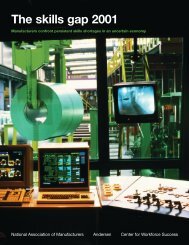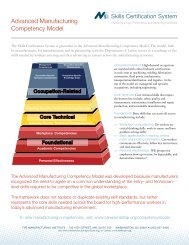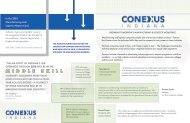2005 Skills Gap Report - Manufacturing Institute
2005 Skills Gap Report - Manufacturing Institute
2005 Skills Gap Report - Manufacturing Institute
Create successful ePaper yourself
Turn your PDF publications into a flip-book with our unique Google optimized e-Paper software.
<strong>2005</strong> <strong>Skills</strong> <strong>Gap</strong> <strong>Report</strong><br />
Over the past eight years, which have included noteworthy educational<br />
reforms, employers of all sizes have yet to see an improvement in<br />
the ability of public education institutions to prepare students for the<br />
workplace. When controlling for industry segment, it is noteworthy<br />
that Aerospace and Defense reported “no” 93 percent of time – eight<br />
percentage points higher than the next highest segment, Process<br />
<strong>Manufacturing</strong>. Again, given the skill requirements of working with<br />
highly engineered products, it may not be surprising that the response<br />
was so high in Aerospace and Defense.<br />
When asked to elaborate on the specific deficiencies of the public<br />
education system in preparing students for the workplace, the top<br />
three most frequently cited responses were: basic employability skills<br />
(attendance, timeliness, work ethic, etc.) at 55 percent, math and science<br />
at 51 percent, and reading and comprehension at 38 percent.<br />
As Figure 17 illustrates, these same top three responses appeared in<br />
the 2001 report.<br />
<br />
<br />
<br />
<br />
<br />
<br />
<br />
<br />
<br />
<br />
<br />
<br />
<br />
<br />
<br />
<br />
<br />
As with the 2001 survey, employers continue to cite basic employability<br />
skills as the single most frequent deficiency among employees.<br />
This, of course, presents an interesting challenge to the public education<br />
system and society overall. Even if schools perform well in their<br />
traditional role of increasing math, science and reading comprehension<br />
skills, this would not address the top, pressing concern of employers<br />
– the need for attendance, timeliness, and work ethic.<br />
Given that traditional approaches are inadequately addressing these<br />
urgent issues, additional dialogue between manufacturers and the<br />
public education system is required regarding standards and expectations<br />
and the role that schools are playing in the preparation of<br />
students for the workplace. This effort should focus on better understanding<br />
the policies and practices that may have hindered schools<br />
in turning out students ready to work – from the types of teachers<br />
and career counselors that are hired, to disincentives that are in place<br />
holding students back even when they are qualified for advancement,<br />
limited parental interest in education, and a lack of school board<br />
awareness in changing workplace skill requirements.<br />
When asked what they themselves are doing to address the skills gap<br />
via the public education system, 32 percent of respondents indicated<br />
that they are participating in state or local business organizations that<br />
promise educational reform. However, companies are not attempting<br />
to achieve reform only from the “outside.” They also are working<br />
directly with schools on a number fronts, such as participating in<br />
career days, hiring students for internships, and having employees act<br />
as mentors to students. The frequency of respondents’ participation in<br />
these activities is shown in Figure 18.<br />
<br />
<br />
<br />
17







